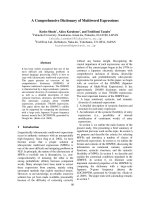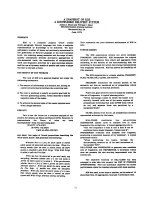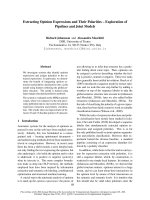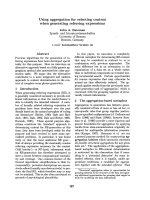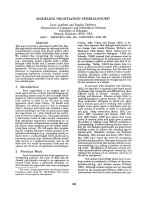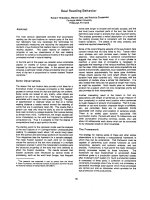Báo cáo khoa học: "COOKINGUP REFERRING EXPRESSIONS" pot
Bạn đang xem bản rút gọn của tài liệu. Xem và tải ngay bản đầy đủ của tài liệu tại đây (494.79 KB, 8 trang )
COOKING UP REFERRING EXPRESSIONS
Robert Dale
Centre for Cognitive Science, University of Edinburgh
2 Buccleuch Place, Edinburgh EH8 9LW, Scotland
email: rda~uk, ac. ed. epJ.stemi~nss, c s. ucl. ac. uk
ABSTRACT
This paper describes the referring expression
generation mechanisms used in EPICURE, a com-
puter program which produces natural language
descriptions of cookery recipes. Major features of
the system include: an underlying ontology which
permits the representation of non-singular entities;
a notion of
diacriminatory power,
to determine
what properties should be used in a description;
and a PATR-like unification grammar to produce
surface linguistic strings.
INTRODUCTION
EPICURE (Dale 1989a, 1989b) is a natural lan-
guage generation system whose principal concern
is the generation of referring expressions which
pick out complex entities in connected discourse.
In particular, the system generates natural lan-
guage descriptions of cookery recipes. Given a top
level goal, the program first decomposes that goal
recursively to produce a plan consisting of oper-
ations at a level of detail commensurate with the
assumed knowledge of the hearer. In order to de-
scribe the resulting plan, EPICURE then models
its execution, so that the processes which produce
referring expressions always have access to a rep-
resentation of the ingredients in the state they are
in at the time of description.
This paper describes that part of the system
responsible for the generation of subsequent refer-
ring expressions, i.e., references to entities which
have already been mentioned in the discourse. The
most notable features of the approach taken here
are as follows: (a) the use of a sophisticated un-
derlying ontology, to permit the representation of
non-singular entities; (b) the use of two levels of se-
mantic representation, in conjunction with a model
of the discourse, to produce appropriate anaphoric
referring expressions; (c) the use of a notion of dis-
crimiaatory
power, to determine what properties
should be used in describing an entity; and (d) the
use of a PATR-1ike unification grammar (see, for ex-
ample, Karttunen (1986); Shieber (1986)) to pro-
duce surface linguistic strings from input semantic
structures.
THE REPRESENTATION OF
INGREDIENTS
In most natural language systems, it is assumed
that all the entities in the domain of discourse are
singular individuals. In more complex domains,
such as recipes, this simplification is of limited
value, since a large proportion of the objects we
find are masses or sets, such as those described
by the noun phrases
two ounces of salt
and
three
pounds of carrots
respectively.
In order to permit the representation of enti-
ties such as these, EPICURE makes use of a notion
of a generalized physical object or
physob].
This
permits a consistent representation of entities irre-
spective of whether they are viewed as individuals,
masses or sets, by representing each as a
knowledge
base entity
(KBE) with an appropriate
structure at.
tribute. The knowledge base entity corresponding
to
three pounds of carrots,
for example, is that
shown in figure 1.
A knowledge base entity models a physobj in a
particular
state.
An entity may change during the
course of a recipe, as processes are applied to it:
in particular, apart from gaining new properties
such as being peeled, chopped, etc., an ingredient's
structure
may change, for example, from set to
mass. Each such change of state results in the
creation of a new knowledge base entity. Suppose,
for example, a grating event is applied to our three
pounds of carrots between states so and sl: the
entity shown in figure i will then become a mass of
grated carrot, represented in state sl by the KBE
shown in figure 2.
BUILDING A REFERRING
EXPRESSION
To construct a referring expression corresponding
to a knowledge base entity, we first build a deep se-
68
KBE
-~
indus
= ZO
state
= so
structure =
set
quantity
=
[
num~erUnit
= pound= 3
]
speC = structure = individual
substance =
carrot
-, [ ]
packaging = ehape= carrot
• = regular
8| Ze
Figure
1:
The knowledge base entity corresponding to three
pounds of carrots
KBE
=
irides = zo
state Sl
strt~|urc = m~8o
qu4ntity =
[
unit = pound ]
spec
= number =
3
substar~e
= carrot
grated = +
Figure 2: The knowledge base entity corresponding to
three pound8 of grated carrot
mantic structure
which specifies the semantic con-
tent of the noun phrase to be generated. We call
this the
recoverable
semantic content, since it con-
sists of just that information the hearer should
be able to derive from the corresponding utter-
ance, even if that information is not stated explic-
itly: in particular, elided elements and instances of
oae-anaphora are represented in the deep seman-
tic structure by their more semantically complete
counterparts, as we will see below.
From the deep semantic structure, a
surface
semantic
structure is
then constructed.
Unlike
the
deep semantic structure, this closely matches the
syntactic structure of the resulting noun phrase,
and is suitable for passing directly to a PATR-like
unification grammar. It is at the level of surface
semantic structure that processes such as elision
and one-anaphora take place.
PRONOMINALIZATION
When an entity is to be referred to, we first check
to see if pronominalisation is possible. Some pre-
vious approaches to the
pronominalization deci.
don
have taken into account a large number of
contextual factors (see, for example, McDonald
(1980:218-220)). The approach taken here is rel-
atively simple. EPICURE makes use of a discourse
model which distinguishes two principal compo-
nents, corresponding to Grosz's (1977) distinction
between local focus and global focus. We call that
part of the discourse model corresponding to the
local focus
cache
memory: this contains the lex-
ical, syntactic and semantic detail of the current
utterance being generated, and the same detail for
the previous utterance. Corresponding to global
focus, the discourse model consists of a number
of hierarchically-arranged
focua
spaces, mirroring
the structure of the recipe being described. These
focus spaces record the semantic content, but not
the syntactic or lexlcal detail, of the remainder
of the preceding discourse. In addition, we make
use of a notion of
discourse
centre: this is intu-
itively similar to the notion of centering suggested
by (]ross, Joshi and Weinstein (1983), and corre-
sponds to the focus of attention in the discourse.
In recipes, we take the centre to be the result of
69
the previous operation described. Thus, after an
utterance like
Soak the butterbeaa.s
the centre is
the entity described by the noun phrase
the but-
terbeans. Subsequent references to the centre can
be pronominalized, so that the next instruction in
the recipe might then be
Drain and
dnse
tltem.
Following Grosz, Joshi and Weinstein (1983),
references to other entities present in cache mem-
ory may also be pronominalized, provided the cen-
tre is pronominalized. 1
If the intended referent is the current centre,
then this is marked as part of the
status
infor-
mation in the deep semantic structure being con-
structed, and a null value is specified for the struc-
ture's descriptive content. In addition, the verb
case frame used to construct the utterance speci-
fies whether or not the linguistic realization of the
entity filling each case role is obligatory: as we
will see below, this allows us to model a common
linguistic phenomenon in recipes
(recipe contezt
empty objects,
after Massam and Roberge (1989)).
For
a case
role whose surface realization is obliga-
tory, the resulting deep semantic structure is then
as follows:
D$ =
inde: : :
[ N~en = +
statttm
:
e.cntrs
: t
sem :
oblig -~
+
"Pec = [ "PC=q) I
This will be realized as either a pronoun or an
elided NP, generated from a surface semantic struc-
ture which is constructed in accordance with the
following rules:
• If the
status
includes the features
[centre, +]
and [oblig, +], then there should be a cor-
responding element in the surface semantic
structure, with a null value specified for the
descriptive content of the noun phrase to be
generated;
t We do not permit pronominal reference to entities last
mentioned before the previous utterance: support for this
restriction comes from a study by Hobbs, who, in a sam-
ple of one hundred consecutive e~.amples of pronouns from
each of three very different texts, found that 98% of an-
tecedents were either in the same or previous sentence
(Hobbs 1978:322-323). However, see Dale (1988) for a sug-
gestion as to how the few instances of/onc-dbt~a.e pronom-
inalimtion that do exist might be explained by means of a
theory of discourse structure like that suggested by Gross
and Sidner (1986).
7O
• If
the
status
includes the features [centre,
+]
and
[oblig,-],
then this participant should
be omitted from the surface semantic struc-
ture altogether.
In the former case, this will result in a pronominal
reference as in Remove them, where the surface se-
mantic structure corresponding to the pronominal
form is as follows:
ind~z = z
status
: [
SS =
"1
given = + |
J
centre = ~r
oblig = +
[ nu~ = pl
agr
8p~ ~ C CG$~ = GCC
&*c =
However, if the participant is marked as non-obligatory,
then reference to the entity is omitted, as in the
following:
Fry the onions.
Add the
garlic
~b.
Here, the case frame for
add
specifies that the in-
direct object is non-obllgatory; since the entity
which fills this case role is also the centre, the
complete prepositional phrase
to the onions
can
be elided. Note, however, that the entity corre-
sponding to the
onions
still figures in the deep
semantic structure; thus, it is integrated into the
discourse model, and is deemed to be part of the
semantic content recoverable by the hearer.
FULL DEFINITE NOUN PHRASE
REFERENCE
If pronominalization is ruled out, we have to build
an appropriate description of the intended refer-
ent. In EPICURE, the process of constructing a
description is driven by two principles, very like
Gricean conversational maxims (Grice 1975). The
p~'nciple
of adequacy
requires that a referring ex-
pression should identify the intended referent un-
ambiguously, and provide sufficient information to
serve the purpose of the reference; and the
princi-
ple of e~ciency,
pulling in the opposite direction,
requires that the referring expression used must
not contain more information than is necessary for
the task at hand. 2
These principles are implemented in EPICUItE
2Similar considerations are discussed by Appelt (1985).
DS ~
inde= ~ =
status =.
[
given = +
unique = +
eel'n ~-
opec =
agr
=
tvpe=
I
countable = + ]
J
number =
pl
category
:
olive
$ize : regular
props
=
pitted
= +
Figure 3: The deep semantic structure corresponding to
the pitted olives
#tat*t.
=
epee
=
a/yen= + ]
unique = +
[countable
:
-~ ]
agr
= number =
pl
]
head = olive
dee¢ = mad= [ head = pltted ]
Figure 4: The surface semantic structure corresponding to
the pitted olives
by means of a notion of
discriminatory power.
Sup-
pose that we have a set of entities U such that
U = {zl,z2, ,x,}
and that we wish to distinguish one of these en-
tities, zl, from all the others. Suppose, also, that
the domain includes a number of attributes (a I, a~,
and so on), and that each attribute has a number
of permissible values {v,,t, v,,2, and so on}; and
that each entity is described by a set of attribute-
value pairs. In order to distinguish z~ from the
other entities in U, we need to find some set of
attribute-value pairs which are together true of zl,
but of no other entity in U. This set of attribute-
value pairs constitutes a
distinguishing
descriptior,
of xl with respect to the ,~ontext U. A
mini-
mal
distinguishing description is
then a set of such
attribute-value pairs, where the cardinality of that
set is such that there are no other sets of attribute-
value pairs of lesser cardinality which are sufficient
to distinguish the intended referent.
We find a minimal distinguishing description
by observing that different attribute-value pairs
differ in the effectiveness with which they distin-
guish an entity from a set of entities. Suppose
U has N elements, where N > I. Then, any
attribute-value pair true of the intended referent
zl will be true of n entities in this set, where
n >_ i. For any attribute-value pair < a, v > that
is true of the intended referent, we can compute
the discriminatory power (notated here as F) of
that attribute-value pair with respect to U as fol-
lows"
~'(<
~,v>, U) =
~-'~
l<n<N
F thus has as its range the interval [0,1], where
a value of 1 for a given attribute-value pair indi-
cates that the attribute-value pair singles out the
intended referent from the conte×t, and a value of
7]
DS -~-
indez
=
z2
status
=
SSf~t
SpSC -~
[ #/uen=
+
]
unique = +
number = sg
agr = countable +
type =
]
categorl! = capsicum
r
I eolour = red
properties
L
size = small
Figure 5: The deep semantic structure corresponding to the small red capsicum
SS =
indez = z2
,
unique = +
i
Jpsc =
_ ~
nu,n~sr= so ]
agr- [ countable = + J
Figure
6: The
surface semantic structure corresponding to
the small red one
0 indicates that the attribute-value pair is of no
assistance in singling out the intended referent.
Given an intended referent and a set of entities
from which the intended referent must be distin-
guished, this notion is used to determine which set
of properties should be used in building a descrip-
tion which is both adequate and efficient. 3 There
remains the question of how the constituency of
the set U of entities is determined: in the present
work, we take the context always to consist of the
working set.
This is the set of distinguishable enti-
sstrictly speaking, this mechanism is only applicable in
the form described here to those properties of an entity
which are realizable by what are known as abJolute (or t~-
tereect/ee or pred~tiee) adjectives (see, for example, Kamp
(1975), Keenan and FaRm (1978)). This is acceptable in
the current domain, where many of the adjectives used are
derived from the verbs used to describe processes applied
to entities.
ties in the domain at any given point in time: the
constituency of this set changes as a recipe pro-
ceeds, since entities may be created or destroyed. 4
Suppose, for example, we determine that we
must identify a given object as being a set of olives
which have been pitted (in a context, for example,
where there are also olives which have not been
pitted}; the corresponding deep semantic struc-
ture is then as in figure 3.
Note that this deep semantic structure can
be realized in at least two ways: as either the
olives
which
have been pitted or the pitted olives.
4A slightly
more
sophisticated approach would be to
restrict U to exclude those entities which are, in G rosz and
Sidner's (1986) terms, only present in closed focus spaces.
However, the benefit gained from doing this (if indeed it is a
valid thing to do) is minimal in the current context because
of the small number of entities we are dealing with.
72
indez
=
z
~tatt~
=
.[ ]
number
=
pl
agr
=
"ountable
=
+
DS
= ~.nuant
8pec =
8ubst
=
]
t number 3 ]
agr = countable = +
tltpe categorlt = pound ]
number
=
pl l
agr = countable
= +
J
type = category = carrot ]
J
Figure 7: The deep semantic structure corresponding to
three pounds of carrots
Both forms are possible, although they correspond
to different
surface
semantic structures. Thus,
the generation algorithm is non-deterministic in
this respect (although one might imagine there are
other factors which determine which of the two re-
alizations is preferrable in a given context}. The
surface semantic structure for the simpler of the
two noun phrase structures is as shown in figure 4.
ONE ANAPHORA
The algorithms employed in EPICURE also permit
the generation of onc-anaphora, as in
Slice the large green capsicum.
Now remove the top of the small red one.
The deep semantic structure corresponding to the
noun phrase
the small
red one is as shown in fig-
ure 5.
The mechanisms which construct the surface
semantic structure determine whether one-anaphora
is possible by comparing the deep semantic struc-
ture corresponding to the previous utterance with
that corresponding to the current utterance, to
identify any elements they have in common. The
two distinct levels of semantic representation play
an important role here: in the deep semantic struc-
ture, only the basic semantic category of the de•
scription has special status (this is similar to Wel>-
her's
(1979)
use of restricted quantification), whereas
the embedding of the surface semantic structure's
dcsc
feature closely matches that of the noun phrase
to be generated. For one-anaphora to be possi-
ble, the two deep semantic structures being com-
pared must have the same value for the feature
addressed by the path <sere
spec
type category>.
Rules which specify the relative ordering of ad-
jectives in the surface form are then used to build
an appropriately nested surface semantic structure
which, when unified with the grammar, will result
in the required one-anaphoric noun phrase. In the
present example, this results in the surface seman-
tic structure in figure 6.
PSEUDO-PARTITI'VE NPS
Partitive and pseudo-partitive noun phrases, ex-
emplified
by
half of the carrots
and
three pounds of
carrots
respectively, are very common in recipes;
EPICURE is capable of generating both. So, for
example, the pseudo-partitive noun phrase
three
pounds of carrots (as
represented by the knowledge
base entity shown in figure 1) is generated from the
deep semantic structure shown in figure 7 via the
surface semantic structure shown in figure 8.
The generation of partitive noun phrases re-
quires slightly different semantic structures, de-
scribed in greater detail in Dale
(1989b).
THE UNIFICATION GRAMMAR
Once the required surface semantic structure has
been constructed, this is passed to a unification
73
$S =
ind.= = z
atatua=
8era
epee =
. [ giuen = ]
countable
=
+
agr
= number = 3
epec I =
&so
=
$p¢c2 =
]
t countable
= +
age
=
number
=
3
desc =
head
=
pound
agr= [[eountab|e=+
d¢8c =
head
=
carrot
Figure 8: The surface semantic structure corresponding to
three pounds of carrots
grammar. In EPICURE, the grammar consists of
phrase structure rules annotated with path equa-
tions which determine the relationships between
semantic units and syntactic units: the path equa-
tions specify arbitrary constituents (either com-
plex or atomic) of feature structures.
There is insufficient space here to show the en-
tire NP grammar, but we provide some representa-
tive rules in figure 9 (although these rules are ex-
pressed here in a PATR-Iike formalism, within EPI-
CURE they are encoded as PROLOG definite clause
grammar (DCG) rules (Clocksin and Mellish 1981)).
Applying these rules to the surface semantic struc-
tures described above results in the generation of
the appropriate surface linguistic strings.
CONCLUSION
In this paper, we have described the processes used
in EPICURE to produce noun phrase referring ex-
pressions. EPICURE is implemented in C-PROLOG
running under UNIX. The algorithms used in the
system permit the generation of a wide range of
pronominal forms, one-anaphoric forms and full
noun phrase structures, including partitives and
pseudo-partitives.
ACKNOWLEDGEMENTS
The work described here has benefited greatly from
discussions with Ewan Klein, Graeme Ritchie, :Ion
Oberlander, and Marc Moens, and from Bonnie
Webber's encouragement.
REFERENCES
Appelt, Douglas E. (1985) Planning English Refer-
ring Expressions.
Artificial Intelligence,
26, 1-33.
Clocksin, William F. and Melllsh, Christopher S.
(1981)
Programming in Prolog.
Berlin: Springer-
Verlag.
Dale, Robert (1988) The Generation of Subsequent
Referring Expressions in Structured Discourses.
Chapter 5 in Zock, M. and Sabah, G. (eds.)
Ad-
uances in Natural Language Generation: An Inter-
disciplinary Perspective,
Volume 2, pp58-75. Lon-
don: Pinter Publishers Ltd.
Dale, Robert (1989a) Generating Recipes: An Over-
view of EPICURE. Extended Abstracts of the Sec-
ond European Natural Language Generation Work-
shop, Edinburgh, April 1989.
Dale, Robert (1989b) Generating Referring Ex-
pressions in a Domain of Objects and Processes.
PhD Thesis, Centre for Cognitive Science, Univer-
sity of Edinburgh.
Grice, H. Paul (1975) Logic and Conversation. In
Cole, P. and Morgan, J. L. (eds.)
Syntax and Se-
mantics,
Volume 3:
Speech Acts,
pp41-58. New
York: Academic Press.
Grosz, Barbara J. (1977} The Representation and
Use of Focus in Dialogue. Technical Note No. 151,
74
NP
N2
Nll
NPx
NPI
4.
Dee N1
<Dee sere>
<NP 8yn agr>
<N1 syn agr>
<Dee syn agr>
<N1 sere>
N
<N
sent>
AP NI2
<AP sere>
<NI~ sere head>
<NP2 sere>
<N1
sere>
<NI 8yn ayr>
<NPa
8era
statuJ>
<NP2
sere status>
<NPa 8era>
<PP
8era>
= <NP sere status>
= <NP sere
spec
agr>
= <NP syn agr>
= <N1 syn agr>
= <NP
sere
spec desc>
= <N1 sent head>
= <Nll sere rood>
<Nlx sere head>
= <NPx sere spec desc specx >
= <NPx sere spec desc
spe¢2>
= <NPx sere
spec
agr>
= <NPz sere status>
= <NPx sere status>
= <NPx sere spec desc
spec>
= <NPx sere
spec
desc set>
Figure 9: A fragment of the noun phrase grammar
SRI
International, Menlo Park, Ca., July, 1977.
Grosz, Barbara J., Joshi, Aravind K. and Wein-
stein, Scott (1983) Providing a Unified Account of
Definite Noun Phrases in Discourse. In
Proceed-
ings of the ~lst Annual Meeting
o/the
Associa-
tion for Computational Linguistics,
Massachusetts
Institute of Technology, Cambridge, Mass., 15-17
June, 1983, pp44-49.
Grosz, Barbara J. and Sidner, Candace L. (1986)
Attention, Intentions, and the Structure of Dis-
course.
Computational Linguistics,
12, 175-204.
Hobbs, Jerry R. (1978) Resolving Pronoun Refer-
ences.
Lingua, 44,
311-338.
Kamp, Hans (1975) Two Theories about Adjec-
tives. In Keenan, E. L. (ed.)
Formal Semantics of
Natural Language: Papers from a colloquium spon-
sored by King's College Research Centre, Cam-
bridge,
pp123-155. Cambridge: Cambridge Uni-
versity Press.
Karttunen, Lauri (1986) D-PATR: A Development
Environment for Unification-Based Grammars. In
Proceedings of the 11th International Conference
on Computational
Linguistics, Bonn, 25-29 Au-
gust, 1986, pp74-80.
Keenan, Edward L. and Faltz, Leonard M. (1978)
Logical Types for Natural Language.
UCLA Occa-
sional Papers in Linguistics, No. 3.
McDonald, David D. (1980) Natural Language Gen-
eration as a Process of Decision-Making under Con-
straints. PhD Thesis, Department of Computer
Science and Electrical Engineering, MIT.
Massam, Diane and Roberge, Yves (1989) Recipe
Context Null Objects in English.
Linguistic In-
quiry,
20, 134 139.
Shieber, Stuart M. (1980)
An Introduction to Unification-
based Approaches to Grantmar.
Chicago, Illinois:
The University of Chicago Press.
Webber, Bonnie Lynn (1979)
A Formal Approach
to Discourse Anaphora.
London: Garland Pub-
lishing.
75
